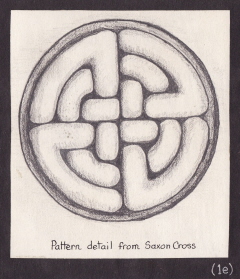P. A. Dee
A Study of St. Andrew's Church, Aycliffe Village
All work displayed on this page remain the copyright of P. A. Dee
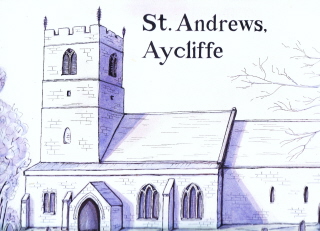
St. Andrew's , Aycliffe
Aycliffe is an ancient village situated about six miles north of Darlington . It is a pleasant village which has attempted to maintain its rural identity in the fast moving 20 th Century.
The Parish Church of St. Andrew’s is not a noticeably dominant feature of the village as it is situated on the outskirts away from the centre of the village community and can easily be overlooked by passing visitors travelling the Great North Road.
St. Andrew’s has a Saxon foundation and the present Church is mostly 12 th and 13 th Century. The church has in its possession twelve fragments of cross shafts and headstones of Saxon origin.
The Chancel is Saxon and was extended to its present size in the 12 th Century. The Nave is Early English, the North aisle is 12 th Century and the South aisle is 13 th Century.
The solid looking main tower is Norman , probably having been built , as so many of these Churches, at the time of the construction of Durham Cathedral. There are fragments from two Saxon Crosses commemorating either a religious or military event in Aycliffe in A.D. 782 and A.D. 789. The Pews and Pulpit are Jacobean.
The interior of the Church is large and spacious, the design of the windows in the North and South aisles are not alike, probably due to a Century of time between their construction. The South aisle windows being relatively plain arched but with no real decorative stonework; the windows in the North aisle being smaller but triple arched with decorative stonework.
There are several fragments of Saxon stone carvings but these are for the most part badly eroded; there are also two interesting tomb covers, one for a 14 th Century Vicar, the other depicting a reclining knight.
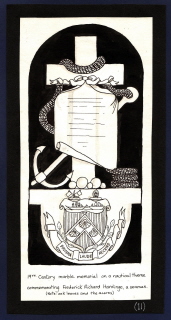
CHANCEL MEMORIAL
The imposing memorial shown in illustration (1l) is relatively modern in comparison with the other religious remains in the Church. Made from black and white veined marble it is situated in the Chancel . One will note the nautical theme of the design, the inclusion of anchor and shells. This is presumabl y because it is dedicated to a sailor, Frederick Richard Hardinge, a mate on H.M.S. Encounter, who died from dysentery in the China Seas in 1856 aboard the Royal Naval Hospital ship, Hercules. The possible reason for such an elaborate memorial to a ship’s mate is probably due to the fact that he was the son of the local Squire. Again note the inclusion of oak leaves and acorns, embracing the coat of arms at the base identifying the memorial with the Aycliffe parish.
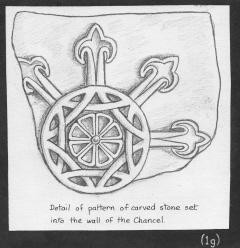
CHANCEL CARVINGS
The present Chancel was built in the 12th Century but it has Saxon foundations and evidence of this is shown by the inclusion of carved Saxon panels in the stonework of the walls.
Sketch (1f), is part of a grave cover. The top of the cross is depicted by broken circles linked together with parallel bands. The sword represents that the grave was that of a man. Sketch (1g) is detail of a fragment of a grave cover showing the decorative interweaving bands of the 'flower' cross popular with the style of that era.
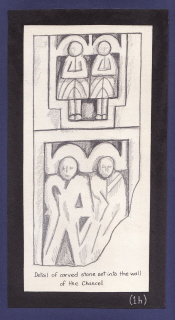
CHANCEL CARVINGS
Embedded in the stonework of the Chancel walls is rather a large fragment of stone relief carving shown in Sketch (1h). Again badly eroded, but nevertheless one can see evidence of two panels. The top panel depicting two nimbed figures, arms across the breasts and a geometric linear design on the tunics. The lower panel has part of it missing but again has two larger nimbed figures where the flow of the garments appears to be more fluid than the figures above them.
Where the carving shown in sketch (1h) originated from can only be speculated, the style and use of nimbed figures is not usually found on grave covers, so possibly this could be a fragment from the shaft of a Saxon cross.
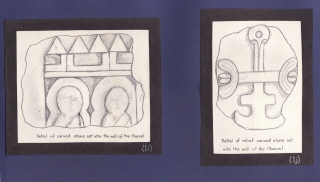
CHANCEL CARVINGS
Sketches (1i) and (1j, are detail from two smaller fragments of carvings in the Chancel walls. Sketch (1i) show~ the top half of what are presumably nimbed figures, above the heads of these figures is rather a geometric style of carving which is unique in the fragments of this Church.
Sketch (1j), is puzzling, as where it originated from and what it represents is obscure. It could be a fragment from the decorative top of a cross carving from a grave cover, but personally it appears to take the form of an anchor, but why and, if indeed carvings of anchors were part of Saxon imagery, remains a mystery, as the design remains unique to the Saxon carvings studied in other Churches.
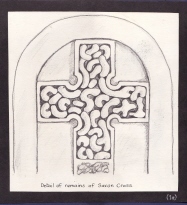
SAXON CROSSES
The sketch 1a is detail of the top of a broken cross situated at the back of the Church. Within the arch of the stone is a carved Saxon cross in relief presumably decorated with interlacing knotwork typical of the Saxon period. It is unusual in the respect that it is not the usual cross shaft design so popular in that era, but rather a depiction of it within the arched shape of the stone. Unfortunately the stone is badly eroded and the sketch shows this in the visual irregularity of the decorative carving; before erosion, the design would have probably been regular and symmetrical in the style of the Saxon stone masons.
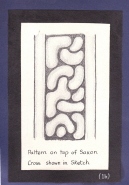
SAXON CROSSES
The sketch 1b is detail of the top of the stone cross shown in sketch (1a). Again the design is of the knotwork style to correspond with the design on the interior of the cross shape depicted on the main face of the cross. The irregularity of the design is again apparent in the sketch due to erosion.
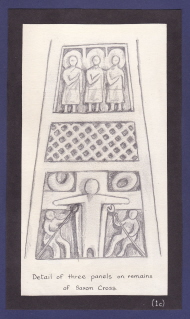
SAXON CROSSES
Sketch (1c), is detail of three carved panels on the fragment of a Saxon cross shaft again situated at the rear of the Church. The bottom panel shows the crucifixion, the body of Jesus is rectangular in shape and is represented standing on the ground with the face turned to the left. Beneath are two soldiers, the one on the right of Jesus is holding a spear, the other an annular object on a long shaft representing a cup or a sponge. The carved spaces on either side of the top of the cross represent the sun and the moon. The middle panel in the sketch is a transverse band containing knotwork. The top panel depicts three nimbed figures all alike with their feet turned sideways to the right and the hands clasped on the breast, long tunics to the ankles and girdles somewhat below the waist.
The design of the figures is very stiff and static and the representation is often obscure. However, there seems to be with most Saxon designs whether of figures or objects a traditional form of symmetry.
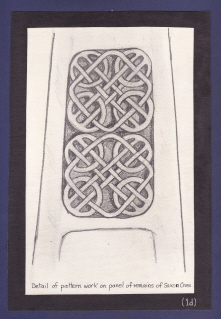
SAXON CROSSES
Sketches (1d) and (1e) are detail from the same fragment of cross shaft. Sketch (1d), although taken from a badly eroded panel, one could still see the form in which the interlacing pattern took. The pattern was based on a lozenge shaped band interwoven with circles and crossing parallel bands, again the symmetry of the design is evident. Sketch (1e), shows the detail of a circular pattern which was the centre design of the top of the cross, although the extended arms of the cross were for the most part missing. The circle design shows the regularity of form favoured by the Saxon stone masons.
